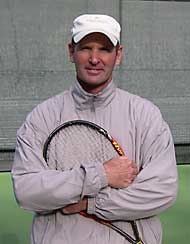|
TennisOne Lessons The Contact Zone Defined Doug King Page 2 One should strive to create a moment of force just before contact. This is done by going from a loose state to a firmer state at just the right moment. To accomplish this requires a period of acceleration that speeds up the action just prior to and continuing through contact. But this acceleration is more than just swinging the racquet faster through the contact zone. In fact, the racquet must continue to maintain good alignment to the ball and the target and even moments after the contact is made, the racquet should be held in alignment to the target. The racquet head can be delayed or restrained in the contact zone in order to create more stored energy which in turn can help to lend more speed and power to the action but directly through the contact the racquet and wrist should be stabilized to achieve consistent alignment to the ball and target. Aside from a change in speed that the acceleration achieves, it also marks a change from the reactive to the active states of the stroke. At the moment of acceleration in the Contact Zone the basic nature of the stroke changes from “catching” the ball to “throwing” the ball. This is the “trigger” moment of the stroke. This distinct change of speed and feel all occurs in the very small space and time of the Contact Zone. At the moment that one gets tense or forceful they compromise their ability to adjust so if this happens too soon it will lead to frequent mis-hitting of the ball. Feel how to “adjust” the hand to the ball so that you are bringing the hand to the ball more reactively, more fluidly, and with more focus on trying to get the ball and the hand to come together into contact. Then, after you get the feeling of catching, add a toss back. Eventually try to blend the motions together. You will also learn through this exercise that if you control your hand properly through contact you will achieve more accuracy in the placement of your return of the ball. If you keep your palm flat and extend your palm out to the target you will have more success than if you flick your fingers or wrist at the ball. This is the same way the racquet should be controlled through the contact to achieve proper control and consistency. On the underspin strokes there is more of a feeling of using the open palm (forehand) or back of the hand (backhand) to meet the ball. In either case the objective is to learn how to let the racquet align to become part of the hand. This is different than holding the racquet in a way that allows you to simply swing the racquet. The hand should drive the racquet and not the other way around.
Practicing shortcourt or mini-tennis is a great way to establish your grip alignments, your body alignments and your squaring up technique. Shortcourt will minimize timing and positioning difficulties, and will provide an opportunity for more control and repetition, allowing you to focus on the subtleties of contact rather than on generating force. Even the top pros will warm-up with this practice to insure that they start with good feels and good touches. Often we think that “good touch” has to do with taking speed off of shots or playing delicate disguise shots, but I like to think that every stroke involves a “touch.” In fact, I see the words “contact” and “touch” as being interchangeable in most cases. Even if you are blasting a penetrating shot from the baseline, it still must include a good “touch” of the ball, meaning that at contact you must have great alignment between all of the elements of the stroke, and have a feeling of grabbing or gripping the ball. Your comments are welcome. Let us know what you think about Doug King's article by emailing us here at TennisOne.
Doug is one of the country's foremost tennis teaching innovators. Founder of Acceleration Tennis, a revolutionary teaching system, King is leading the way in reinterpreting the traditional tennis model. Doug King is currently Director of Tennis at Meadowood Napa Valley ( www.meadowood.com ), a Relaix Chateau Resort in St. Helena , CA . For more information on Acceleration Tennis please email Doug King at dking@meadowood.com. |

 Doug King studied with legendary tennis coach Tom Stow and was a
former California State Men's Singles Champion
and the former number one men's player of Northern California.
Doug King studied with legendary tennis coach Tom Stow and was a
former California State Men's Singles Champion
and the former number one men's player of Northern California.